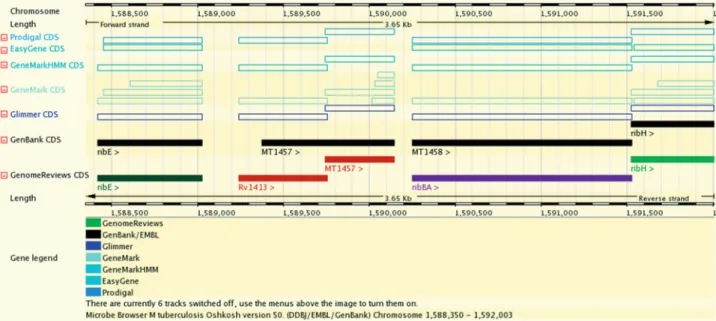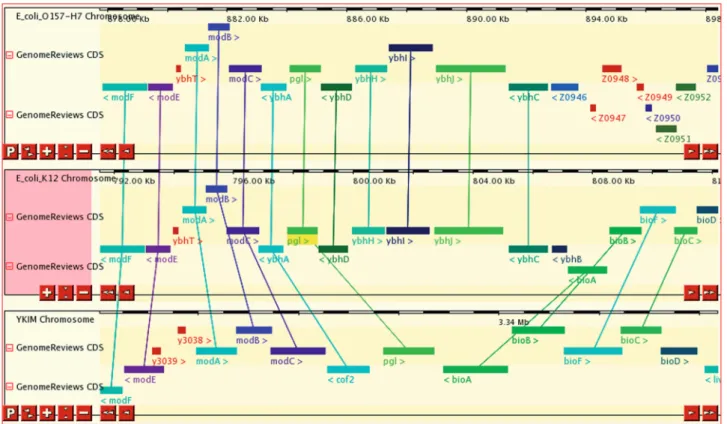W296–W299 Nucleic Acids Research, 2009, Vol. 37, Web Server issue Published online 30 April 2009 doi:10.1093/nar/gkp268
The Microbe browser for comparative genomics
Alexandre Gattiker
1,2, Christophe Dessimoz
1,3, Adrian Schneider
1,3,
Ioannis Xenarios
1,4, Marco Pagni
1,4and Jacques Rougemont
1,2,*
1
Swiss Institute of Bioinformatics (SIB), 2School of Life Sciences, Ecole Polytechnique Fe´de´rale de Lausanne (EPFL), 1015 Lausanne, 3Institute of Computational Science, ETH Zu¨rich, 8092 Zu¨rich and 4Vital-IT, Baˆtiment Ge´nopode, Universite´ de Lausanne, 1015 Lausanne, Switzerland
Received January 27, 2009; Revised April 3, 2009; Accepted April 11, 2009
ABSTRACT
The Microbe browser is a web server providing comparative microbial genomics data. It offers com-prehensive, integrated data from GenBank, RefSeq, UniProt, InterPro, Gene Ontology and the Orthologs Matrix Project (OMA) database, displayed along with gene predictions from five software packages. The Microbe browser is daily updated from the source databases and includes all completely sequenced bacterial and archaeal genomes. The data are dis-played in an easy-to-use, interactive website based on Ensembl software. The Microbe browser is avail-able at http://microbe.vital-it.ch/. Programmatic access is available through the OMA application programming interface (API) at http://microbe. vital-it.ch/api.
INTRODUCTION
About a thousand complete microbial genomes have been sequenced to date [961 genomes in the Genomes On Line Database (GOLD) on 1 April 2009 (1)], and many differ-ent methods have been used to predict genes, yielding large differences in gene annotation even across closely related species. No single computational method yet achieves perfect gene predictions. Furthermore, very few entries have been kept up-to-date in the primary databases such as GenBank (2). We therefore felt that it was impor-tant to provide a unified interface to the various gene pre-diction packages to allow biologists to evaluate them in their genomic and evolutionary contexts.
This leads to another important computational chal-lenge, namely the identification of orthologs. Many stu-dies, such as the prediction of gene function, phylogenetic reconstruction and genomics context analyses, depend on accurate predictions of orthology. Among genes that share a common ancestor, only genes that are separated by a speciation event are actual orthologs (3). To address the need for reliable ortholog sources, several initiatives have been created for better ortholog prediction [see (4) for a
comparison]. Among these resources, Orthologs Matrix Project (OMA) stands out by its efficient and robust com-putational method allowing continuous updating with novel genomes (5) and its ability to exclude non-orthologs, conferring a high reliability in the prediction of true ortho-logous relationships (4).
Interactive genome browsers have proved invaluable to the community for visualizing genes and experimental data in their genomic context, and as hubs connecting many biomedical databases (6,7). Genome browsers also provide comparative genomics information by displaying homologous regions in a single view. However, most browsers concentrate on eukaryotic genomes, so that bio-logists working on microbial genomes are restricted to standalone programs such as the Artemis Comparison Tool (8) or web sites such as the Joint Genome Institute’s Integrated Microbial Genomes tools (http:// img.jgi.doe.gov/) or GeneDB (http://www.genedb.org) that are more complex to use, can only handle a few gen-omes at a time and do not integrate as much information via a single interface.
Derived genomic databases that connect and expand reference databases are important in particular for auto-mated analyses such as dataset comparisons. The EBI Genome Reviews database (9) provides complete genome sequence and annotation data, continuously updated and extended with automated and manual anno-tation in UniProtKB (10). The NCBI RefSeq resource (11) provides a coherent set of sequences, genes and tran-scripts, some of which have been manually annotated. Frustratingly, the EBI and NCBI resources use distinct sets of identifiers (UniProtKB accession number and pro-tein_id for EBI; RefSeq accession number, GeneID and GI number for NCBI) that make it hard to navigate between databases using different references. Further-more, UniProtKB curators not only extend and unifor-mize annotation, but they also modify gene sequences, changing translational start site predictions, correcting frameshifts or adding genes missing from the original sub-mission. This information is propagated to Genome Reviews but not to the source DDBJ/EMBL/GenBank entries, which can only be modified by the original *To whom correspondence should be addressed. Tel: +41 21 693 9573; Fax: +41 21 693 1850; Email: jacques.rougemont@epfl.ch
ß 2009 The Author(s)
This is an Open Access article distributed under the terms of the Creative Commons Attribution Non-Commercial License (http://creativecommons.org/licenses/ by-nc/2.0/uk/) which permits unrestricted non-commercial use, distribution, and reproduction in any medium, provided the original work is properly cited.
submitter. This introduces an additional divergence between databases, as it becomes non-trivial to identify the ‘same’ gene in two different databases where the gene might have neither the same identifier scheme nor the same coordinates.
The Integr8 database (9) aggregates curated informa-tion on completely sequenced genomes, including taxon-omy down to the precise strain level, and cross-references to all chromosomes and plasmids comprising the complete genome.
We introduce the Microbe browser, a web server that uses the Integr8 database to organize and correlate geno-mic sequences and annotation from the GenBank, Genome Reviews and RefSeq databases. We use the powerful Ensembl web code (7) to present the resulting data in a fully interactive, user-friendly and platform-independent manner.
METHODS
Source data are retrieved daily from primary public servers. Integr8 and Genome Reviews are the source of genome data, including curated gene sets and annotation and cross-references to UniProtKB, InterPro, Gene Ontology and the Protein Data Bank. GenBank and RefSeq are the source of NCBI cross-references (RefSeq accession, GeneID and GI number). The OMA database provides orthology predictions for pairs of genes. Pre-computed gene predictions from the Glimmer (12), GeneMark, GeneMarkHMM (13) and Prodigal (http:// compbio.ornl.gov/prodigal) packages are provided by the NCBI, and predictions by the EasyGene method (14) are downloaded from the EasyGene web site (http:// servers.binf.ku.dk/cgi-bin/easygene/search).
The Genome Reviews data are used as a reference, because it incorporates substantial automatic and manual annotation from the gold standard UniProtKB knowledgebase (10). Cross-references from GenBank and RefSeq genes are merged into Genome Reviews records based on the position of the 30-end of the genes.
This allows to correctly map not only genes for which no cross-references exist between the databases, but also those for which the 50-end (start site) has been possibly
changed by UniProtKB curators.
USAGE
The Microbe browser home page is used for organism selection and search term input, which can be a gene name or a cross-reference to any of the source databases. Several view pages are available, the three most informa-tive are detailed below. The user can easily navigate across those pages and detailed online help is available.
The gene report page integrates data on gene sequence and annotation, orthologs and cross-references to the major biological databases.
The chromosome view pages (Figure 1) display the original genome annotation submitted in the DDBJ/ EMBL/GenBank source databases, the modified annota-tion from UniProtKB (via Genome Reviews) and the gene predictions of several popular packages.
The chromosome comparison pages (Figure 2) display regions surrounding orthologous genes in two or more organisms, highlighting orthology relationships between them, and reveal cases of synteny (co-localized orthologs). This display scales up to comparing a few species with detailed positional information, while specialized software Figure 1. Chromosome view of Mycobacterium tuberculosis CDC 1551. GenBank source annotation (black full boxes), Genome Reviews reference annotation from UniProtKB (coloured full boxes) and predictions from five software packages (hollow boxes). UniProtKB curators have altered the most likely translational start site of the MT1457 gene by similarity to other genomes and created a novel conserved gene identical to M. tuberculosis H37Rv gene Rv1413.
has been proposed to visualize synteny across dozens of species in a summarized display (15).
For software developers, programmatic access to the orthology relationships is available via web services through the OMA APIs at http://microbe.vital-it.ch/api. CONCLUSION
Designed primarily for biomedical researchers, the Microbe browser runs an easy-to-use, interactive view allowing to visualize gene predictions, orthology and syn-teny relationships and to navigate across databases. Data originates from established bioinformatics databases: DDBJ/EMBL/GenBank source genomic data, annotation and cross-references to the major biological databases retrieved from Genome Reviews and RefSeq, pairwise gene orthology predictions from OMA, and alternative gene predictions from several prediction packages. Future developments will include fungal genomes and metagenomic data.
ACKNOWLEDGEMENTS
We thank R. Fabbretti and V. Flegel for IT support, and also A. Auchincloss, T. Lima and A. Kapopoulou for critical reading.
FUNDING
Swiss Institute of Bioinformatics. Funding for open access charge: Swiss Institute of Bioinformatics and Ecole Polytechnique Fe´de´rale de Lausanne.
Conflict of interest statement. None declared.
REFERENCES
1. Liolios,K., Mavromatis,K., Tavernarakis,N. and Kyrpides,N.C. (2008) The Genomes On Line Database (GOLD) in 2007: status of genomic and metagenomic projects and their associated metadata. Nucleic Acids Res., 36, D475–D479.
2. Benson,D.A., Karsch-Mizrachi,I., Lipman,D.J., Ostell,J. and Sayers,E.W. (2009) GenBank. Nucleic Acids Res., 37, D26–D31. 3. Fitch,W.M. (1970) Distinguishing homologous from analogous
proteins. Syst. Zool., 19, 99–113.
4. Altenhoff,A.M. and Dessimoz,C. (2009) Phylogenetic and functional assessment of orthologs inference projects and methods. PLoS Comp. Biol., 5, e1000262.
5. Roth,A.C., Gonnet,G.H. and Dessimoz,C. (2008) Algorithm of OMA for large-scale orthology inference. BMC Bioinformatics, 9, 518.
6. Kuhn,R.M., Karolchik,D., Zweig,A.S., Wang,T., Smith,K.E., Rosenbloom,K.R., Rhead,B., Raney,B.J., Pohl,A., Pheasant,M. et al. (2009) The UCSC Genome Browser Database: update 2009. Nucleic Acids Res., 37, D755–D761.
7. Hubbard,T.J., Aken,B.L., Ayling,S., Ballester,B., Beal,K., Bragin,E., Brent,S., Chen,Y., Clapham,P., Clarke,L. et al. (2009) Ensembl 2009. Nucleic Acids Res., 37, D690–D697.
8. Carver,T., Berriman,M., Tivey,A., Patel,C., Bo¨hme,U.,
Barrell,B.G., Parkhill,J. and Rajandream,M.A. (2008) Artemis and ACT: viewing, annotating and comparing sequences stored in a relational database. Bioinformatics, 24, 2672–2676.
9. Kersey,P., Bower,L., Morris,L., Horne,A., Petryszak,R., Kanz,C., Kanapin,A., Das,U., Michoud,K., Phan,I. et al. (2005) Integr8 and Genome Reviews: integrated views of complete genomes and proteomes. Nucleic Acids Res., 33, D297–D302.
10. UniProt Consortium. (2009) The Universal Protein Resource (UniProt) 2009. Nucleic Acids Res., 37, D169–D174.
Figure 2. Chromosome comparison view of regions around the pgl gene in Escherichia coli O157:H7, E. coli K12 and Yersinia pestis KIM5. Genes are coloured by InterPro families, and orthologous gene pairs are connected. Among the adjacent mod, ybh and bio genes present in E. coli K12, only two are conserved in synteny in each species.
11. Pruitt,K.D., Tatusova,T., Klimke,W. and Maglott,D.R. (2009) NCBI Reference Sequences: current status, policy and new initiatives. Nucleic Acids Res., 37, D32–D36.
12. Delcher,A.L., Harmon,D., Kasif,S., White,O. and Salzberg,S.L. (1999) Improved microbial gene identification with GLIMMER. Nucleic Acids Res., 27, 4636–4641.
13. Borodovsky,M., Mills,R., Besemer,J. and Lomsadze,A. (2003) Prokaryotic gene prediction using GeneMark and GeneMark.hmm. Curr. Protoc. Bioinformatics, Chapter 4, Unit4.5.
14. Nielsen,P. and Krogh,A. (2005) Large-scale prokaryotic gene prediction and comparison to genome annotation. Bioinformatics, 21, 4322–4329.
15. Lemoine,F., Labedan,B. and Lespinet,O. (2008) SynteBase/ SynteView: a tool to visualize gene order conservation in prokaryotic genomes. BMC Bioinformatics, 9, 536.

